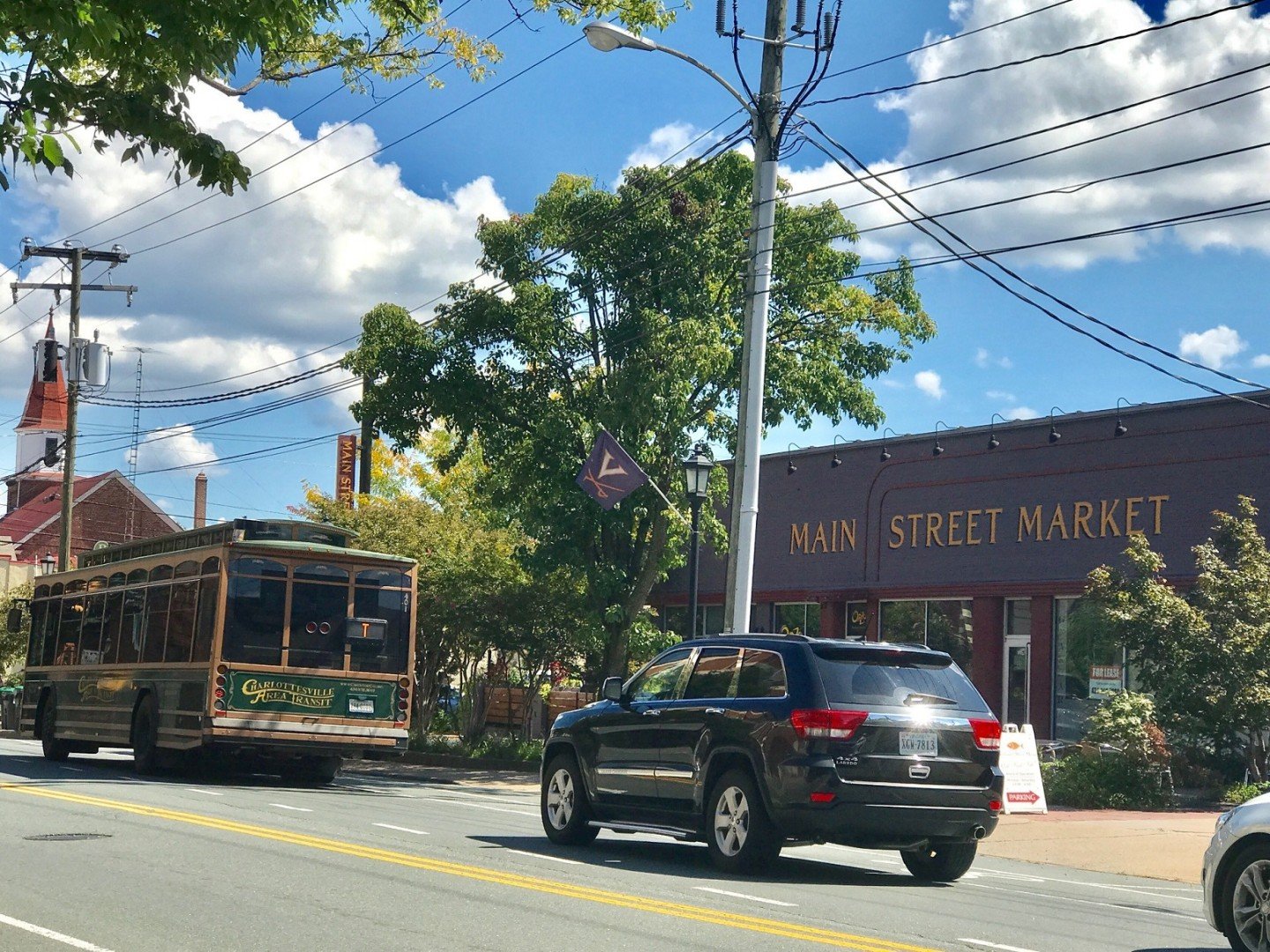CAT’s 10-year Transit Strategic Plan: Advancing Transportation Justice
Introduction
Charlottesville’s City Council will vote on Monday, June 17, whether to approve Charlottesville Area Transit (CAT)’s equity-forward ten-year Transit Strategic Plan (TSP). During the lead-up to the vote, CAT’s public feedback webpage sought input on the draft TSP from residents, for which we at C3 created a set of advocacy talking points [1].
While the process for incorporating public feedback into the Plan from both the initial public engagement and the recent online feedback period was not clearly defined, the TSP nonetheless effectively addresses community concerns identified by C3 in our 2021 Transity Equity and Climate report [2], including reducing overall trip duration, increasing frequency, improving bus stops, and reducing looping in routes.
C3 with the City of Charlottesville and Charlottesville Area Transit (CAT) for a battery electric bus demonstration by GILLIG and Sonny Merryman. (April 2024)
ZEB transition plan identified
There are many things to celebrate in CAT’s TSP, but let’s start with the most climate-forward statement: the Plan works from a basis that from the beginning of 2027, CAT is expected to purchase no new diesel buses, kickstarting its transition to a 100% zero-emission bus (ZEB) fleet [3]! Achieving this timeline will add serious weight to the City's ability to claim progress toward its goal of reducing community greenhouse gas (GHG) emissions 45% by 2030 and achieving carbon neutrality by 2050 [4].
A zero-emission bus fleet is crucial for Charlottesville, where 30% of GHG emissions derive from transportation [5]. As part of a long-term transportation emissions-reduction strategy, getting people out of personal cars and into public transit is an essential form of behavior change, but a fossil-fueled bus fleet can only reduce and not eliminate tailpipe GHG emissions. At present, CAT plans to achieve its service improvements by adding 20 new diesel-powered buses to its fleet before 2027.
In an internal comparative study of GHG emissions per passenger type across private and public transit, C3 has uncovered high ridership and occupancy requirements for fossil-fueled buses to ‘break even’ on emissions replaced from even single-occupancy personal vehicles [6]. A zero-emission bus fleet with no tailpipe emissions allows breathing room (pun intended!) in occupancy and ridership levels needed to achieve a climate ‘break-even’, putting less pressure on CAT to attract unrealistically high levels of ridership to justify the level of service from an emissions perspective.
Service Expansion
The TSP outlines a very welcome objective to increase weekday service on all routes to every 30 minutes at a minimum along with a limited reintroduction of Sunday service, with select services on high-volume routes increasing to every 15 minutes [7]. Increased service frequency has been identified by CAT riders - as well as, crucially, potential CAT riders - as a highly desired service improvement [8].
That being said, the TSP’s assessment that the rate of ridership decline, which had been significant prior to the emergence of COVID-19, was “significantly accelerated” by the pandemic [9] is at odds with CAT’s self-reported ridership numbers to the TSP [see Fig. 1], which shows that when the sharp downturn in ridership during the pandemic is removed, the consistent downward trend is only very slightly altered by its impacts. CAT will have to achieve substantially improved reliability to increase ridership and occupancy across its expanded service. If it can achieve that, then the combination of transitioning to zero-emission buses and increased service will move Charlottesville closer to a clean and decarbonized economy.
Fig. 1: Charlottesville Area Transit: Rides per Year (FTA Data), FY2015-FY2022 [10]
Smart Growth and TOD
C3 is especially glad to see that the TSP emphasizes the benefits of mixed-use planning [11], which is foundational for a successful public transit network. To identify areas of future fixed-route service expansion for the Plan, Kimley Horn conducted a long-view study of likely future areas of high employment density and population density growth, which will be able to support high levels of transit occupancy. C3 strongly supports Transit-Oriented Development (TOD) and smart growth for Charlottesville, and celebrates this hopeful indication that transit and planning will be more closely interlinked in future developments.
C3 supports the TSP's encouragement for CAT to ramp up its pursuit of regional collaboration on transit planning in the form of a Regional Transit Authority (RTA) under the Regional Transit Vision Plan (RTVP). This is aligned with both City and County decarbonization efforts by seeking to create a more robust transit system, and would meet the TSP’s recommendation of better coordination between services - especially if JAUNT and UTS were to join alongside CAT and the County. Assuming that Charlottesville’s City Council and Albemarle County’s Board of Supervisors vote to set up the RTA (slated for the Fall), residents of both jurisdictions will benefit from streamlining transit across the region, with improved connectivity and usability of service.
In addition to improved coordination between schedules and routes, C3 suggests that collaborating on a shared app between all regional transit services would go a long way toward making these services more accessible for the community. Further incorporating the Plan's recommended expansion of MicroCAT, an RTA that brought together CAT (including MicroCAT), JAUNT, UTS and the County would represent a positive move in ensuring access to public transit for those living in areas without the population density to sustain more regular fixed-route service.
Dignity in Equity
The TSP contains an explicit goal of “priotiz[ing] transit service to populations with the greatest need” [12]. This centering of those people for whom better transit connections will have the greatest impact is a foundational approach to transit design, and that priority is evident throughout both the Plan and in the discussions held between CAT and the City at public meetings around the TSP.
As investigated by the TSP, the negative impacts of any reintroduction of fares would include a 10% drop in ridership and reduce CAT's portion of competitive funding under state programs, including a 5% drop in operating assistance from DRPT’s MERIT program [13]. While the City has not yet decided whether to reintroduce fares after the cessation of the DRPT TRIP funding for fare-free travel in July 2026, at the City Council meeting on June 3, C3 was glad to hear Mr. Garland Williams express his opinion that fare-free was an “important positive” for CAT's ridership and service. It is to be hoped that the City will take this as a recommendation to aggressively pursue means of continuing the free fare system, such as by seeking partnerships with private businesses that benefit from having transit stops on or outside their property.
The TSP also sets out a goal of improving passengers’ comfort and safety at bus stops. During Kimley Horn’s presentation of the TSP to City Council on June 3, 2024, Transit Planner Sam Sink noted that bus stop improvements considered will feature basic essentials such as shelters and benches, but may also include trash cans. The inclusion of trash cans - often overlooked in bus stop design - is a good representation of the fact that robust transit systems provide services beyond just moving people from place to place.
Next steps
CAT and City staff have done great work in designing a living, adaptable plan with equity-focused service improvements and a collaborative, climate-conscious vision. Taken as it is, the Plan would transform CAT into a much more usable service, with streamlined service likely to reduce individual passengers’ time spent in transit per trip, affording greater dignity and fewer GHG emissions per passenger mile.
Be that as it may, however, there is still a valuable opportunity for the TSP should be updated to take an even more explicitly climate-forward stance. Specifically, we advocate that before the City Council votes to adopt the TSP, it should be updated to recommend the purchase of diesel-hybrid buses instead of diesel buses for CAT’s fleet expansion, during the transitional period to a fully zero-emission fleet.
We also encourage CAT and the City to seek and incorporate feedback from the community well in advance of the annual update period, so that CAT users and clean transit advocates can see their needs and values even more deeply reflected in future iterations of the Plan. Until then, we at C3 are excited to see these transformative changes to CAT’s service, and congratulate all involved in the design of the TSP for their excellent work!
SOURCES
[1] Community Climate Collaborative (2024), “C3's Suggested Feedback: CAT’s 10-Year Transit Strategic Plan Draft”. Available at: https://static1.squarespace.com/static/5a0c67f5f09ca475c85d7686/t/6646621c53923d2fa79fb84d/1715888668529/TSP+draft+feedback+-+Talking+Points.pdf
[2] Community Climate Collaborative (2021), “Transit Equity and Climate: Moving to a Cleaner Future”. Available at: https://static1.squarespace.com/static/5a0c67f5f09ca475c85d7686/t/61660c5415f23c4de3a1019f/1634077793076/C3%27s+T%26E+-+Full+Report+-+Final+v04.pdf
[3] Charlottesville Area Transit (2024), “Transit Strategic Plan”. Available at: https://www.charlottesville.gov/DocumentCenter/View/11913/CAT-TSP-Full-Document-PDF?bidId=, p.4-2.
[4] City of Charlottesville (2023), “Charlottesville Climate Action Plan”. Available at: https://www.charlottesville.gov/DocumentCenter/View/8776/Charlottesville-Climate-Action-Plan-PDF, p.10.
[5] City of Charlottesville (2023), “Charlottesville Climate Action Plan”. Op cit., p.17.
[6] Sadhbh O’Flynn (2024), “From Pollution to Progress: CAT's Leap Towards Zero-Emission Public Transit”. Available at: https://theclimatecollaborative.org/blog/2024/2/28/increased-ridership-and-zero-emission-buses-a-match-made-in-climate-heaven.
[7]Charlottesville Area Transit (2024), “Transit Strategic Plan”. Op cit., pp.(3-4)-(3-32).
[8] Charlottesville Area Transit (2024), “Transit Strategic Plan”. Op cit., p.2-9.
[9] Charlottesville Area Transit (2024), “Transit Strategic Plan”. Op cit., p.2-47.
[10] Community Climate Collaborative (2024), internal research on ridership as reportedby CAT to FTA. More information available on request.
[11] Charlottesville Area Transit (2024), “Transit Strategic Plan”. Op cit., p.2-12.
[12] Charlottesville Area Transit (2024), “Transit Strategic Plan”. Op cit., p.1-12.
[13] Charlottesville Area Transit (2024), “Transit Strategic Plan”. Op cit., p.5-5.





